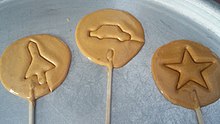
Back Dalgona Czech Dalgona German Dalgona Spanish دالگونا Persian डालगोना Hindi Talgona Hungarian Դալգոնա Armenian Dalgona ID Dalgona Italian タルゴナ Japanese
 | |
| Type | Sugar candy |
|---|---|
| Place of origin | South Korea |
| Associated cuisine | Korean cuisine |
| Main ingredients | Sugar, baking soda |
| Similar dishes | Honeycomb toffee |
| Korean name | |
| Hangul | 달고나 |
|---|---|
| Revised Romanization | dalgona |
| McCune–Reischauer | talgona |
| IPA | [tal.ɡo.na] |
Dalgona (달고나) is a Korean candy made with melted sugar and baking soda originating from South Korea.[1][2] It is a popular street snack from the 1960s, and is still eaten as a retro food.[3] When a pinch of baking soda is mixed into melted sugar, the thermal decomposition of the baking soda releases carbon dioxide, which makes the liquidized sugar puff up and becomes a light and crunchy candy once cooled and hardened.[4] Typically, the creamy beige liquid is poured on a flat surface, pressed flat, and stamped using a cookie cutter giving off the image on the candy such as a star or a heart. Consumers try to trim their way around the outline on the snack without breaking the picture as a challenge.[4] Traditionally, if this trimming is completed without breaking the candy, the consumer receives another free dalgona from the seller.[5]
Modern cafes in Korea serve novel dalgona coffee beverages where dalgona-flavoured coffee cream is heaped on top of iced tea or coffee,[6] as well as pastries such as scones.[7] Some cafes also used dalgona to make desserts such as bingsu and souffle.[8][9]
Dalgona appeared in an episode of the Netflix series Squid Game, with a deadly version of the dalgona challenge being the second game played in the series. The success and international popularity of the show led to a revival of the candy's popularity in South Korea along with the rising prevalence around the world.[10][11] Sales have doubled for dalgona street vendors as foreigners become more interested in the candy.[12][13] People have also taken to social media such as TikTok and YouTube to make their own candy at home as a challenge and as a cooking recipe.[14]
- ^ AsiaToday (31 January 2017). "Korean Cuisine Introduced at JNU International Food Festival". Huffington Post. Retrieved 5 July 2017.
- ^ Cho, Chung-un (24 February 2017). "[Eye Plus] Forgotten past relived at Tongin Market". The Korea Herald. Retrieved 5 July 2017.
- ^ Seoul Metropolitan Government (2010). Seoul Guide Book. Seoul: Gil-Job-E Media. p. 150.
- ^ a b Sohn, Ji-young (3 December 2015). "Creative, eye-catching goods available at Seoul Design Market". The Korea Herald. Retrieved 5 July 2017.
- ^ "How to Make Dalgona Candy! Play Ppopgi from Squid Game". Honest Food Talks. 2021-09-30. Retrieved 2021-10-03.
- ^ Chan, Bernice (7 April 2020). "Story behind dalgona coffee, coronavirus social media craze with roots in South Korea". South China Morning Post. Retrieved April 29, 2020.
- ^ "띵~ 할만큼 달아서… 코로나 두통이 날아가네". The Chosun Ilbo (in Korean). 2020-03-10. Retrieved 2020-04-04.
- ^ 김, 나경 (2021-03-10). "'아내의 맛' 홍현희♥제이쓴, #100억 매출 카페CEO #달고나 수플레의 운명". The Korea Economic Daily (in Korean). Archived from the original on 2021-05-01. Retrieved 2021-05-01.
- ^ 김, 경희. "빙수·스무디·플랫치노 등 이른 더위에 여름 시즌 음료 잇달아 출시". digitalchosun (in Korean). Archived from the original on 2021-04-29. Retrieved 2021-05-01.
- ^ Schlitz, Heather. "I tried making the dalgona candy popularized worldwide by 'Squid Game' and TikTok, and it was surprisingly easy". Business Insider. Retrieved 2022-07-14.
- ^ "Here's how to make viral Dalgona candy from Netflix's Squid Game". The Indian Express. 2021-10-05. Retrieved 2022-07-14.
- ^ Park, Minwoo; Cha, Sangmi (2021-10-01). "Seller basks in 'Squid Game' fame of his 'sweet and deadly' treat". Reuters. Retrieved 2021-10-03.
- ^ Morales, Christina (October 5, 2021). "Why Is Everyone Talking About Dalgona Candy?". The New York Times. Retrieved October 5, 2021.
- ^ Breen, Kerry. "What is the 'Squid Game' cookie craze? The viral food challenge explained". TODAY.com. Archived from the original on 2021-09-29. Retrieved 2021-10-03.